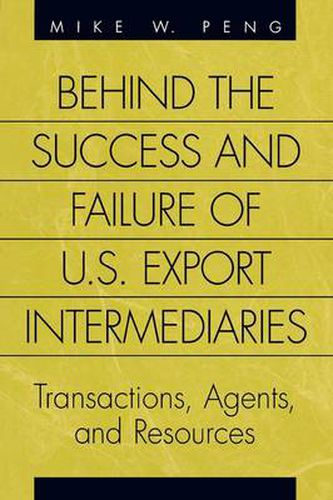Readings Newsletter
Become a Readings Member to make your shopping experience even easier.
Sign in or sign up for free!
You’re not far away from qualifying for FREE standard shipping within Australia
You’ve qualified for FREE standard shipping within Australia
The cart is loading…






Trading across borders, export intermediaries are specialized service firms that connect domestic manufacturers with overseas buyers. How do they do it? What determines their success or failure? Have they really lowered transaction costs for their clients, minimized agency costs, and possessed competitive resources and capabilities in world trade? Surprisingly, no study until now has answered these questions or has explored the underlying issues as thoroughly as Peng does here.
Peng develops an integrated model of export intermediary performance. He focuses on the nature of export transactions and manufacturer-intermediary relationships which may lead to agency problems, and underlines the importance of valuable, unique, and hard-to-imitate resources and capabilities for intermediaries’ competitive advantages. Peng employs a distinct analytical approach that highlights three underlying themes-transactions, agents, and resources-then tests his model with six critical case studies and a 1,000-firm mail survey. Operators of export intermediaries seeking ways to improve their performance, aspiring entrepreneurs studying the export business for niche opportunities, manufacturing executives seeking top quality service from export intermediaries, and government officials in charge of export promotion and pertinent legislation-all will find Peng’s book a useful examination of issues critical to their work.
$9.00 standard shipping within Australia
FREE standard shipping within Australia for orders over $100.00
Express & International shipping calculated at checkout
Trading across borders, export intermediaries are specialized service firms that connect domestic manufacturers with overseas buyers. How do they do it? What determines their success or failure? Have they really lowered transaction costs for their clients, minimized agency costs, and possessed competitive resources and capabilities in world trade? Surprisingly, no study until now has answered these questions or has explored the underlying issues as thoroughly as Peng does here.
Peng develops an integrated model of export intermediary performance. He focuses on the nature of export transactions and manufacturer-intermediary relationships which may lead to agency problems, and underlines the importance of valuable, unique, and hard-to-imitate resources and capabilities for intermediaries’ competitive advantages. Peng employs a distinct analytical approach that highlights three underlying themes-transactions, agents, and resources-then tests his model with six critical case studies and a 1,000-firm mail survey. Operators of export intermediaries seeking ways to improve their performance, aspiring entrepreneurs studying the export business for niche opportunities, manufacturing executives seeking top quality service from export intermediaries, and government officials in charge of export promotion and pertinent legislation-all will find Peng’s book a useful examination of issues critical to their work.